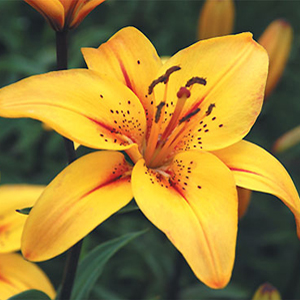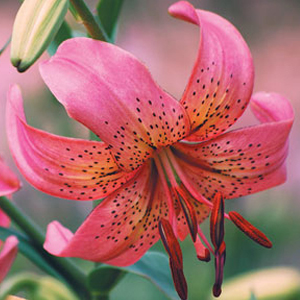



There are many types of flowers that have been called “Lilies,” but many, like the daylily, water lily, and calla lily, actually belong to other groups of flowering plants. True lilies have fleshy scales without a protective outer coating. They are never dormant and produce large, showy, fragrant flowers. They have six petals that are trumpet-shaped and sit on top of tall, erect stems. What is great about lilies is that they are easy to grow and require minimal care.
Location
Lilies tend to bloom in early summer or fall, depending on the type. If you carefully blend early, mid-season, and late varieties, you will enjoy blooms from spring to the first frost. Their ideal location is one with direct sun in the morning and partial shade during the afternoon. Dependable blooms need 6-8 hours of direct sunlight a day. If it is too shady, the stems will lean toward the sun, get spindly, and fall over. Choose a site that drains well. This will be the first place to dry out after a good rain.
Tip: Keep their roots cool by planting them with low growing annuals, perennials, or grasses.
Soil
Lilies like soil that is rich with a pH around 5.5 to 6.5. Keep them in cool, porous, well-drained soil. If your soil is clay or sandy, add large amounts of organic matter or leaf mold. Plant them in fall or spring about 12-18 inches apart. Loosen the soil to a depth of 12 to 15 inches and dig a hole 2 to 3 times as deep as the bulb is high. Place the bulb in pointy side up and fill the hole with soil. Space the bulbs at a distance equal to three times the diameter of the bulb. In late spring, when the soil is consistently warm, add a 3-inch layer of organic mulch around the plants. This helps conserve moisture and keeps the bulbs from becoming too hot in the summer. Feed the plants with a balanced fertilizer every few weeks.
Water
In general, lilies do not need to be watered daily. When you do water, make sure you water deep enough to reach the bulb. Drainage is always an issue for lilies, so plant them in a berm or a raised bed so the water drains away from the bulbs and doesn’t over flood them. Water trapped beneath the scales may rot the bulb.
Displaying Lilies
Lilies are good choices for both formal and natural settings. If you are displaying your lilies as cut flowers, there are a few things to note.
- Avoid cutting off more than a third of the stem. This can reduce the plant’s vigor and longevity.
- When cutting, choose those with buds that are just about to open, with a bit of the flower color showing.
- Trim the stem ends an inch or so, making a diagonal cut with a sharp knife.
- Orange pollen may cause stains, so snip off the stamens in the flower’s center.
- Before arranging in a vase, remove the lower leaves on the stems so that no foliage will be underwater.
- Cut lilies will last two or more weeks. Change the water every few days.
- Prolong the flowers’ live by adding cut flower food to the water.